E-business CRM Solutions: A Detailed Report on Zoho & Salesforce
VerifiedAdded on 2023/04/21
|5
|1171
|76
Report
AI Summary
This report provides a comparative analysis of Customer Relationship Management (CRM) systems, specifically Zoho, Salesforce, and Hubspot, for e-business. It highlights the importance of CRM in managing customer data, improving customer lifetime value, and streamlining business processes. Zoho is presented as an economical CRM with features like social media integration and API for application integration. Salesforce.com CRM is emphasized for delivering personalized buying experiences across multiple channels and enhancing team collaboration. Hubspot CRM is noted for its simplicity, free access, and efficient reporting capabilities, making it suitable for both new and experienced businesses. The report concludes that CRM tools are essential for e-businesses to maintain market positions amidst stiff competition.
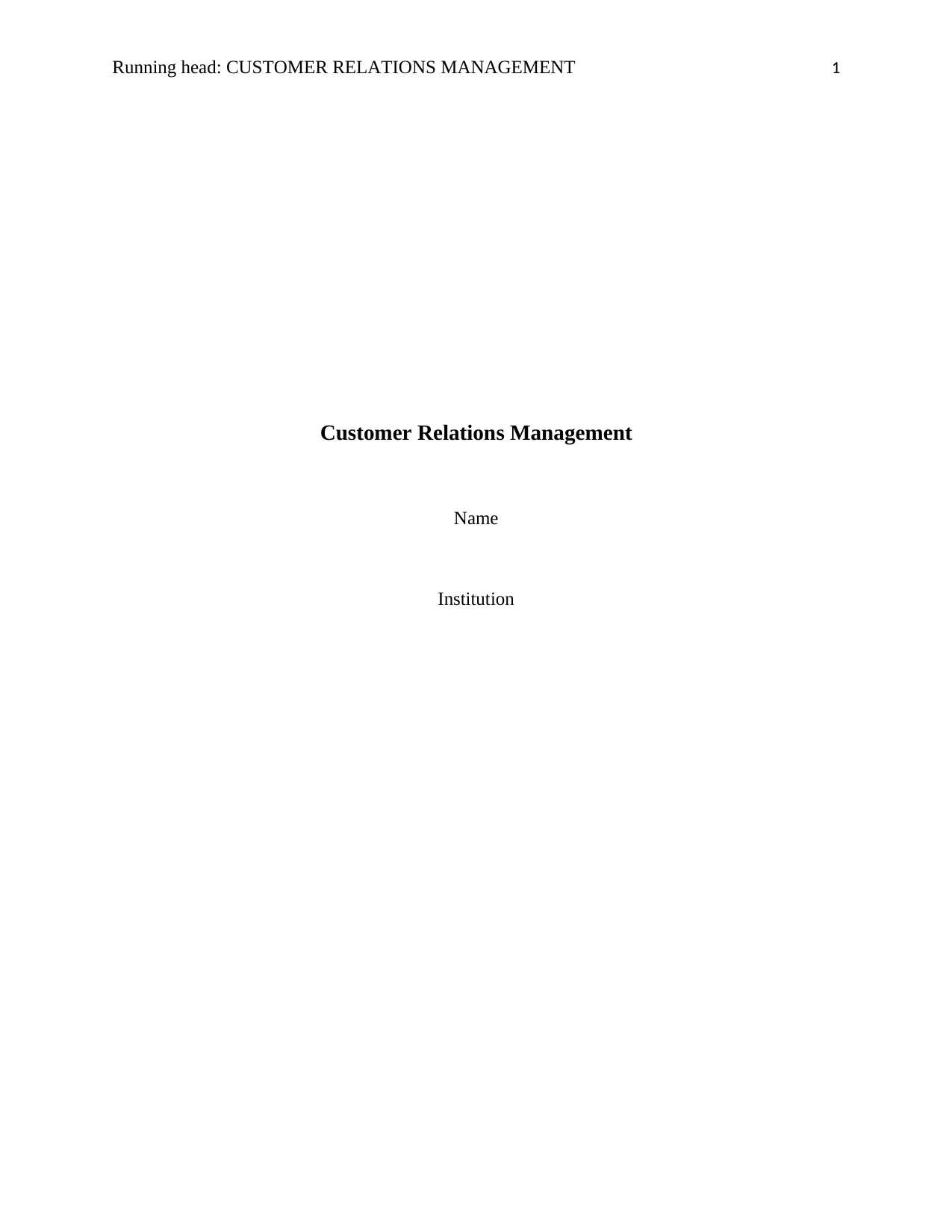
Running head: CUSTOMER RELATIONS MANAGEMENT 1
Customer Relations Management
Name
Institution
Customer Relations Management
Name
Institution
Paraphrase This Document
Need a fresh take? Get an instant paraphrase of this document with our AI Paraphraser
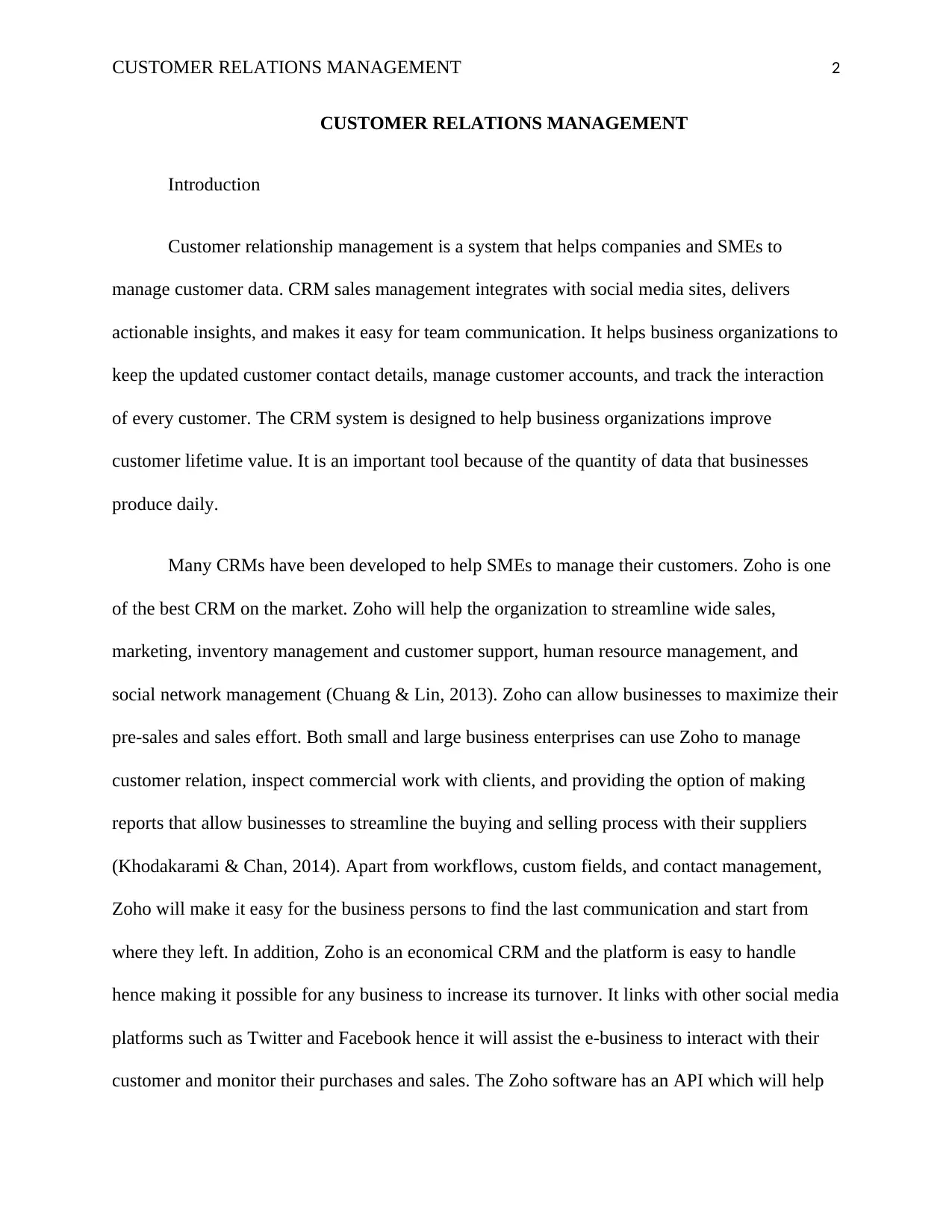
CUSTOMER RELATIONS MANAGEMENT 2
CUSTOMER RELATIONS MANAGEMENT
Introduction
Customer relationship management is a system that helps companies and SMEs to
manage customer data. CRM sales management integrates with social media sites, delivers
actionable insights, and makes it easy for team communication. It helps business organizations to
keep the updated customer contact details, manage customer accounts, and track the interaction
of every customer. The CRM system is designed to help business organizations improve
customer lifetime value. It is an important tool because of the quantity of data that businesses
produce daily.
Many CRMs have been developed to help SMEs to manage their customers. Zoho is one
of the best CRM on the market. Zoho will help the organization to streamline wide sales,
marketing, inventory management and customer support, human resource management, and
social network management (Chuang & Lin, 2013). Zoho can allow businesses to maximize their
pre-sales and sales effort. Both small and large business enterprises can use Zoho to manage
customer relation, inspect commercial work with clients, and providing the option of making
reports that allow businesses to streamline the buying and selling process with their suppliers
(Khodakarami & Chan, 2014). Apart from workflows, custom fields, and contact management,
Zoho will make it easy for the business persons to find the last communication and start from
where they left. In addition, Zoho is an economical CRM and the platform is easy to handle
hence making it possible for any business to increase its turnover. It links with other social media
platforms such as Twitter and Facebook hence it will assist the e-business to interact with their
customer and monitor their purchases and sales. The Zoho software has an API which will help
CUSTOMER RELATIONS MANAGEMENT
Introduction
Customer relationship management is a system that helps companies and SMEs to
manage customer data. CRM sales management integrates with social media sites, delivers
actionable insights, and makes it easy for team communication. It helps business organizations to
keep the updated customer contact details, manage customer accounts, and track the interaction
of every customer. The CRM system is designed to help business organizations improve
customer lifetime value. It is an important tool because of the quantity of data that businesses
produce daily.
Many CRMs have been developed to help SMEs to manage their customers. Zoho is one
of the best CRM on the market. Zoho will help the organization to streamline wide sales,
marketing, inventory management and customer support, human resource management, and
social network management (Chuang & Lin, 2013). Zoho can allow businesses to maximize their
pre-sales and sales effort. Both small and large business enterprises can use Zoho to manage
customer relation, inspect commercial work with clients, and providing the option of making
reports that allow businesses to streamline the buying and selling process with their suppliers
(Khodakarami & Chan, 2014). Apart from workflows, custom fields, and contact management,
Zoho will make it easy for the business persons to find the last communication and start from
where they left. In addition, Zoho is an economical CRM and the platform is easy to handle
hence making it possible for any business to increase its turnover. It links with other social media
platforms such as Twitter and Facebook hence it will assist the e-business to interact with their
customer and monitor their purchases and sales. The Zoho software has an API which will help
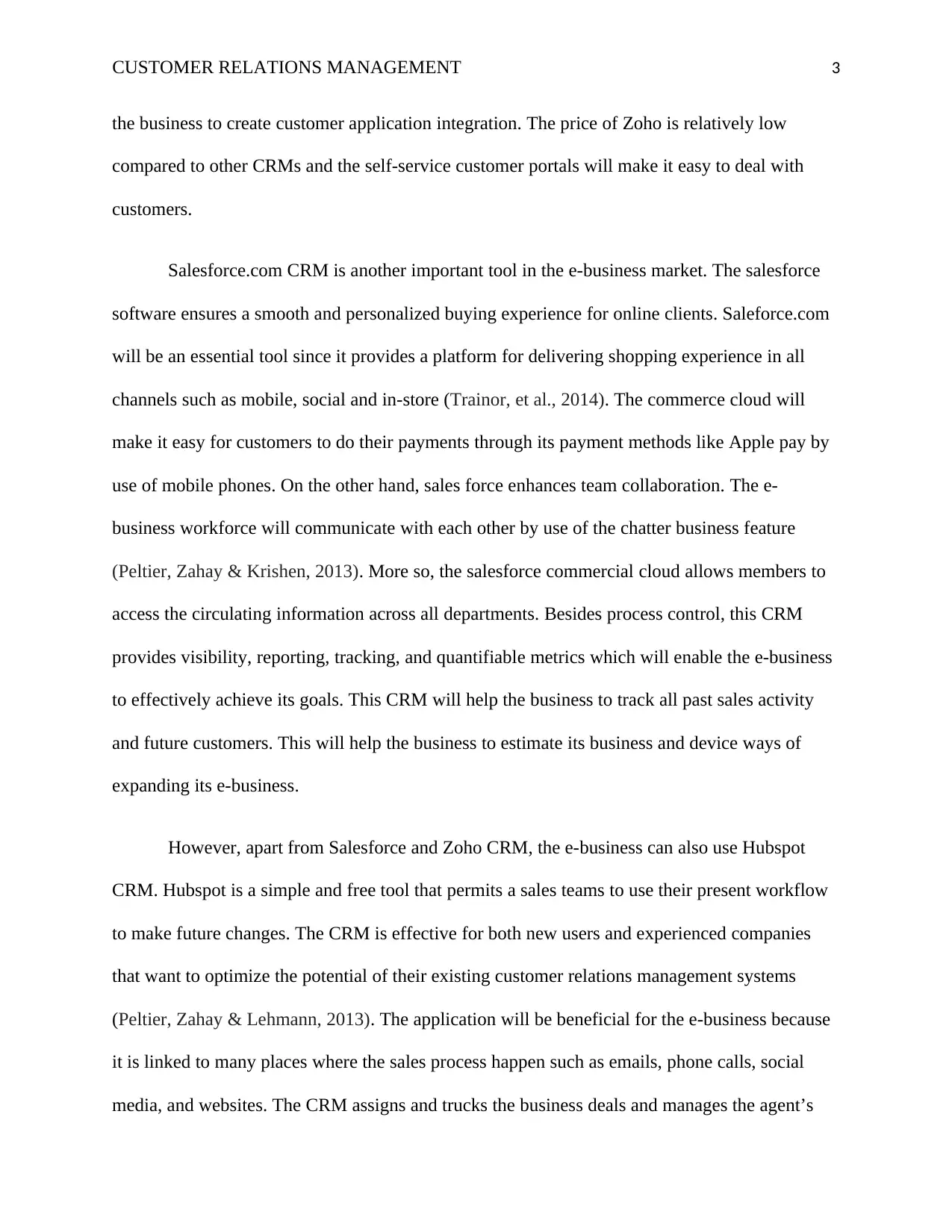
CUSTOMER RELATIONS MANAGEMENT 3
the business to create customer application integration. The price of Zoho is relatively low
compared to other CRMs and the self-service customer portals will make it easy to deal with
customers.
Salesforce.com CRM is another important tool in the e-business market. The salesforce
software ensures a smooth and personalized buying experience for online clients. Saleforce.com
will be an essential tool since it provides a platform for delivering shopping experience in all
channels such as mobile, social and in-store (Trainor, et al., 2014). The commerce cloud will
make it easy for customers to do their payments through its payment methods like Apple pay by
use of mobile phones. On the other hand, sales force enhances team collaboration. The e-
business workforce will communicate with each other by use of the chatter business feature
(Peltier, Zahay & Krishen, 2013). More so, the salesforce commercial cloud allows members to
access the circulating information across all departments. Besides process control, this CRM
provides visibility, reporting, tracking, and quantifiable metrics which will enable the e-business
to effectively achieve its goals. This CRM will help the business to track all past sales activity
and future customers. This will help the business to estimate its business and device ways of
expanding its e-business.
However, apart from Salesforce and Zoho CRM, the e-business can also use Hubspot
CRM. Hubspot is a simple and free tool that permits a sales teams to use their present workflow
to make future changes. The CRM is effective for both new users and experienced companies
that want to optimize the potential of their existing customer relations management systems
(Peltier, Zahay & Lehmann, 2013). The application will be beneficial for the e-business because
it is linked to many places where the sales process happen such as emails, phone calls, social
media, and websites. The CRM assigns and trucks the business deals and manages the agent’s
the business to create customer application integration. The price of Zoho is relatively low
compared to other CRMs and the self-service customer portals will make it easy to deal with
customers.
Salesforce.com CRM is another important tool in the e-business market. The salesforce
software ensures a smooth and personalized buying experience for online clients. Saleforce.com
will be an essential tool since it provides a platform for delivering shopping experience in all
channels such as mobile, social and in-store (Trainor, et al., 2014). The commerce cloud will
make it easy for customers to do their payments through its payment methods like Apple pay by
use of mobile phones. On the other hand, sales force enhances team collaboration. The e-
business workforce will communicate with each other by use of the chatter business feature
(Peltier, Zahay & Krishen, 2013). More so, the salesforce commercial cloud allows members to
access the circulating information across all departments. Besides process control, this CRM
provides visibility, reporting, tracking, and quantifiable metrics which will enable the e-business
to effectively achieve its goals. This CRM will help the business to track all past sales activity
and future customers. This will help the business to estimate its business and device ways of
expanding its e-business.
However, apart from Salesforce and Zoho CRM, the e-business can also use Hubspot
CRM. Hubspot is a simple and free tool that permits a sales teams to use their present workflow
to make future changes. The CRM is effective for both new users and experienced companies
that want to optimize the potential of their existing customer relations management systems
(Peltier, Zahay & Lehmann, 2013). The application will be beneficial for the e-business because
it is linked to many places where the sales process happen such as emails, phone calls, social
media, and websites. The CRM assigns and trucks the business deals and manages the agent’s
⊘ This is a preview!⊘
Do you want full access?
Subscribe today to unlock all pages.

Trusted by 1+ million students worldwide
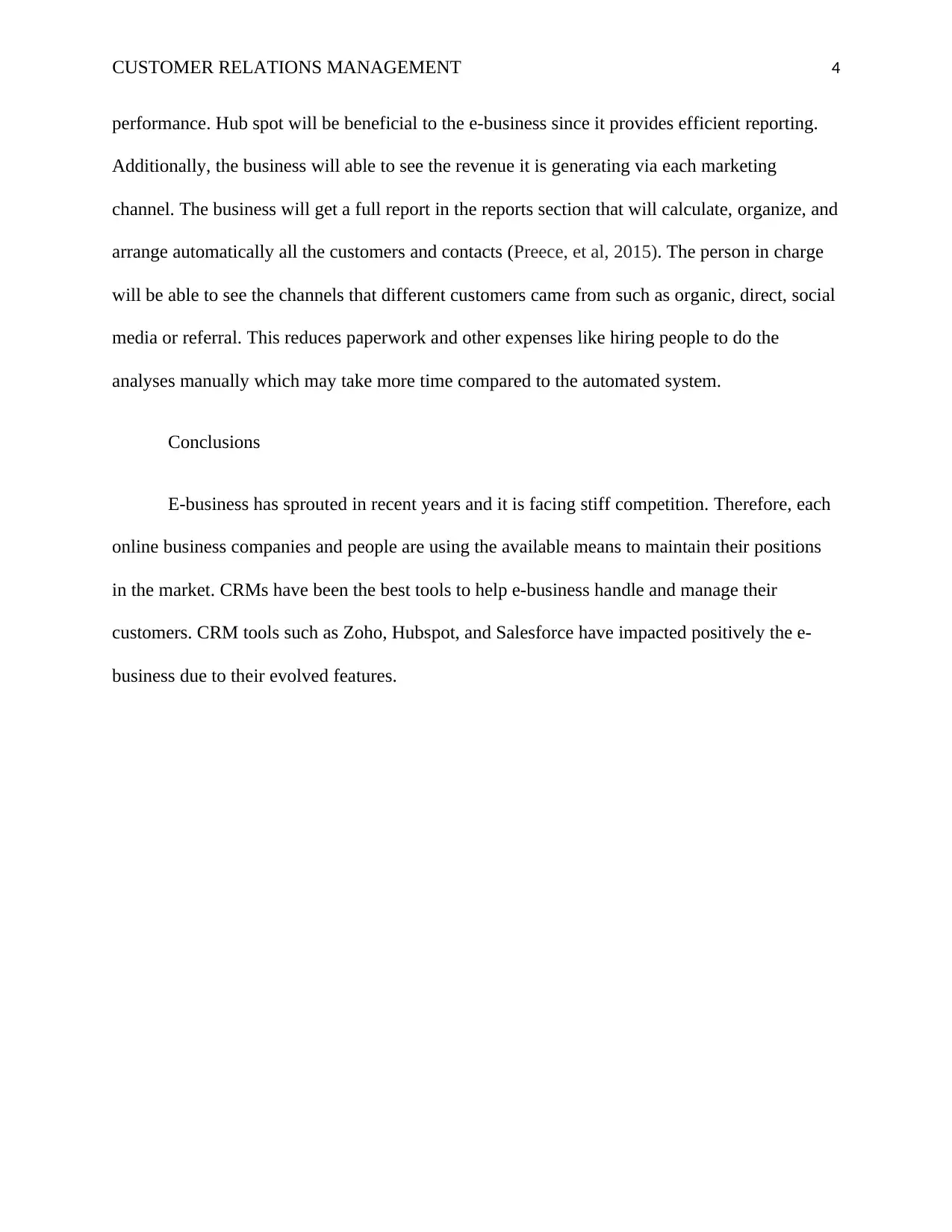
CUSTOMER RELATIONS MANAGEMENT 4
performance. Hub spot will be beneficial to the e-business since it provides efficient reporting.
Additionally, the business will able to see the revenue it is generating via each marketing
channel. The business will get a full report in the reports section that will calculate, organize, and
arrange automatically all the customers and contacts (Preece, et al, 2015). The person in charge
will be able to see the channels that different customers came from such as organic, direct, social
media or referral. This reduces paperwork and other expenses like hiring people to do the
analyses manually which may take more time compared to the automated system.
Conclusions
E-business has sprouted in recent years and it is facing stiff competition. Therefore, each
online business companies and people are using the available means to maintain their positions
in the market. CRMs have been the best tools to help e-business handle and manage their
customers. CRM tools such as Zoho, Hubspot, and Salesforce have impacted positively the e-
business due to their evolved features.
performance. Hub spot will be beneficial to the e-business since it provides efficient reporting.
Additionally, the business will able to see the revenue it is generating via each marketing
channel. The business will get a full report in the reports section that will calculate, organize, and
arrange automatically all the customers and contacts (Preece, et al, 2015). The person in charge
will be able to see the channels that different customers came from such as organic, direct, social
media or referral. This reduces paperwork and other expenses like hiring people to do the
analyses manually which may take more time compared to the automated system.
Conclusions
E-business has sprouted in recent years and it is facing stiff competition. Therefore, each
online business companies and people are using the available means to maintain their positions
in the market. CRMs have been the best tools to help e-business handle and manage their
customers. CRM tools such as Zoho, Hubspot, and Salesforce have impacted positively the e-
business due to their evolved features.
Paraphrase This Document
Need a fresh take? Get an instant paraphrase of this document with our AI Paraphraser
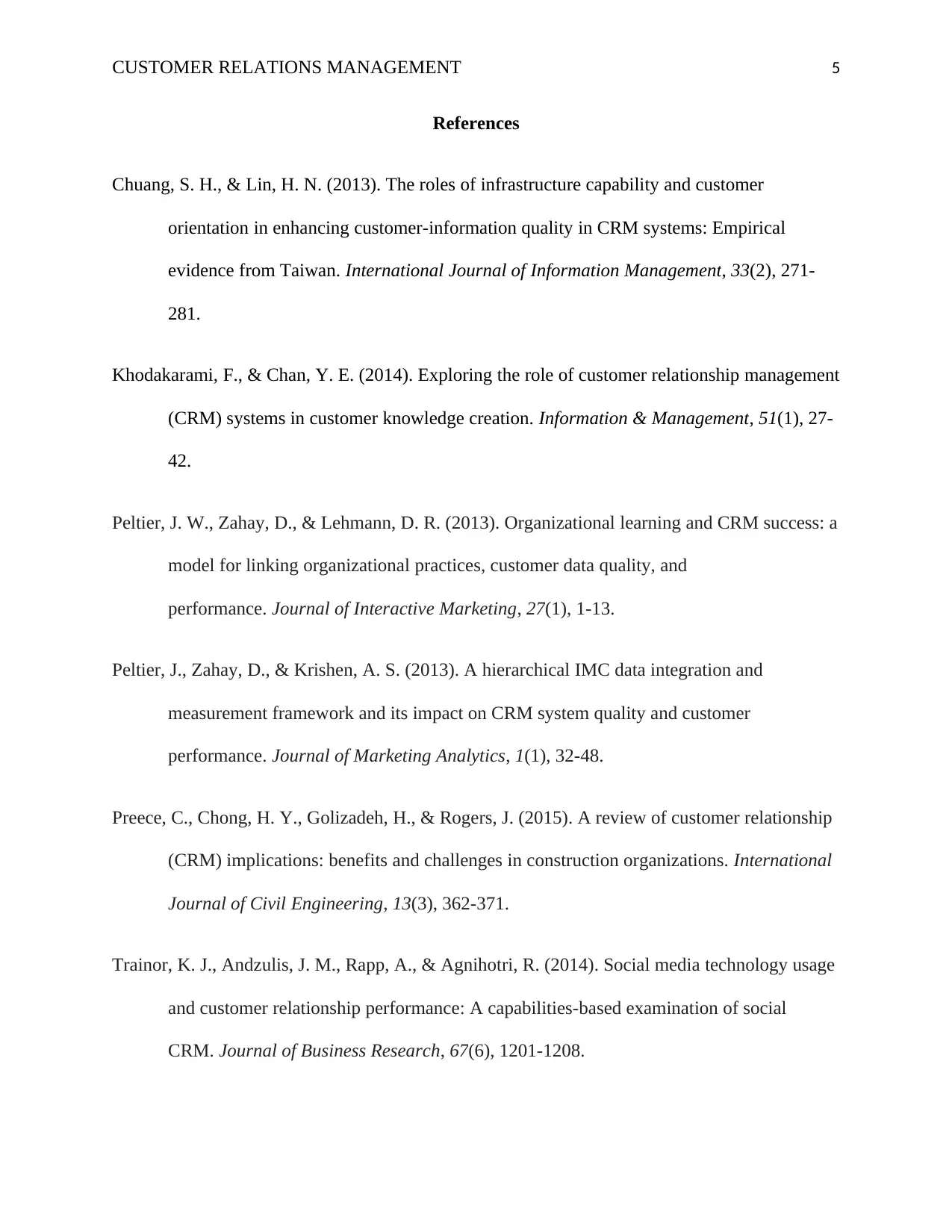
CUSTOMER RELATIONS MANAGEMENT 5
References
Chuang, S. H., & Lin, H. N. (2013). The roles of infrastructure capability and customer
orientation in enhancing customer-information quality in CRM systems: Empirical
evidence from Taiwan. International Journal of Information Management, 33(2), 271-
281.
Khodakarami, F., & Chan, Y. E. (2014). Exploring the role of customer relationship management
(CRM) systems in customer knowledge creation. Information & Management, 51(1), 27-
42.
Peltier, J. W., Zahay, D., & Lehmann, D. R. (2013). Organizational learning and CRM success: a
model for linking organizational practices, customer data quality, and
performance. Journal of Interactive Marketing, 27(1), 1-13.
Peltier, J., Zahay, D., & Krishen, A. S. (2013). A hierarchical IMC data integration and
measurement framework and its impact on CRM system quality and customer
performance. Journal of Marketing Analytics, 1(1), 32-48.
Preece, C., Chong, H. Y., Golizadeh, H., & Rogers, J. (2015). A review of customer relationship
(CRM) implications: benefits and challenges in construction organizations. International
Journal of Civil Engineering, 13(3), 362-371.
Trainor, K. J., Andzulis, J. M., Rapp, A., & Agnihotri, R. (2014). Social media technology usage
and customer relationship performance: A capabilities-based examination of social
CRM. Journal of Business Research, 67(6), 1201-1208.
References
Chuang, S. H., & Lin, H. N. (2013). The roles of infrastructure capability and customer
orientation in enhancing customer-information quality in CRM systems: Empirical
evidence from Taiwan. International Journal of Information Management, 33(2), 271-
281.
Khodakarami, F., & Chan, Y. E. (2014). Exploring the role of customer relationship management
(CRM) systems in customer knowledge creation. Information & Management, 51(1), 27-
42.
Peltier, J. W., Zahay, D., & Lehmann, D. R. (2013). Organizational learning and CRM success: a
model for linking organizational practices, customer data quality, and
performance. Journal of Interactive Marketing, 27(1), 1-13.
Peltier, J., Zahay, D., & Krishen, A. S. (2013). A hierarchical IMC data integration and
measurement framework and its impact on CRM system quality and customer
performance. Journal of Marketing Analytics, 1(1), 32-48.
Preece, C., Chong, H. Y., Golizadeh, H., & Rogers, J. (2015). A review of customer relationship
(CRM) implications: benefits and challenges in construction organizations. International
Journal of Civil Engineering, 13(3), 362-371.
Trainor, K. J., Andzulis, J. M., Rapp, A., & Agnihotri, R. (2014). Social media technology usage
and customer relationship performance: A capabilities-based examination of social
CRM. Journal of Business Research, 67(6), 1201-1208.
1 out of 5
Related Documents
Your All-in-One AI-Powered Toolkit for Academic Success.
+13062052269
info@desklib.com
Available 24*7 on WhatsApp / Email
![[object Object]](/_next/static/media/star-bottom.7253800d.svg)
Unlock your academic potential
Copyright © 2020–2025 A2Z Services. All Rights Reserved. Developed and managed by ZUCOL.





